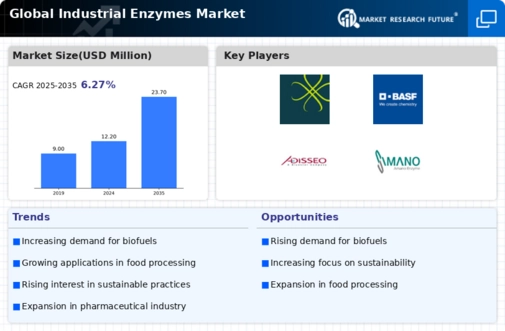Market Analysis
In-depth Analysis of Industrial Enzymes Market Industry Landscape
The Industrial Enzymes Market is characterized by dynamic and evolving trends driven by a combination of factors that influence supply and demand. Enzymes play a crucial role in various industrial processes, including food and beverage, biofuels, textiles, and detergents, contributing to the growth and diversification of the market. One of the key drivers of market dynamics is the increasing demand for sustainable and eco-friendly solutions across industries. As industries seek alternatives to traditional chemical processes, enzymes emerge as a viable option due to their ability to enhance efficiency while minimizing environmental impact. Anticipated to hold a dominant position during the forecast period, the North American market is poised to lead the industrial enzymes sector. A primary catalyst for this market dominance is the rapid growth observed in various application industries within the region. The escalating demand for industrial enzymes in North America is significantly driven by the flourishing application sectors, which span diverse industries.
This commanding position is further substantiated by the region's proactive adoption of advanced technologies and innovative industrial practices. As key industries in North America continue to expand and diversify, the need for industrial enzymes has witnessed a substantial surge. This burgeoning demand can be attributed to the pivotal role played by industrial enzymes in enhancing manufacturing processes, optimizing efficiency, and facilitating eco-friendly practices.
Moreover, the North American market's dominance in the industrial enzymes sector is reflective of a dynamic landscape where advancements in biotechnology and industrial applications converge. The region's commitment to staying at the forefront of industrial innovation positions it as a hub for the increasing demand for enzymes across various industrial verticals. Consequently, North America emerges as a key player in steering the trajectory of the global industrial enzymes market. Globalization also plays a significant role in shaping the market dynamics of industrial enzymes. The interconnectedness of economies has led to the exchange of technologies and innovations, contributing to the widespread adoption of enzymes in diverse industries. Moreover, the awareness of the benefits associated with enzymatic processes, such as reduced energy consumption and waste generation, has fueled the market's growth. As regulatory bodies worldwide continue to emphasize environmentally friendly practices, industries are compelled to incorporate enzyme-based solutions into their operations, further propelling the market forward.
Innovation is a driving force behind the market dynamics of industrial enzymes. Companies in the enzyme industry constantly invest in research and development to enhance the functionality and specificity of enzymes for various applications. This continuous innovation not only expands the range of industries that can benefit from enzymatic processes but also fosters competition among market players. The pursuit of novel enzyme formulations and improved production techniques creates a dynamic landscape, with companies vying to offer superior and cost-effective solutions to meet the evolving needs of diverse industries.
Market dynamics are also influenced by the increasing emphasis on bio-based products. With a growing awareness of the environmental impact of conventional manufacturing processes, industries are turning towards bio-based alternatives, and enzymes play a pivotal role in this transition. The shift towards sustainable practices aligns with consumer preferences for eco-friendly products, influencing manufacturers to incorporate enzymatic solutions into their production processes. This consumer-driven demand for sustainable practices further contributes to the fluidity of the market as companies adapt to changing preferences.
The Industrial Enzymes Market is not without challenges. Price volatility of raw materials, stringent regulatory requirements, and the complexity of integrating enzymatic processes into existing industrial setups pose hurdles for market players. However, these challenges also create opportunities for innovation and differentiation among companies, fostering resilience and adaptability within the market.







Leave a Comment